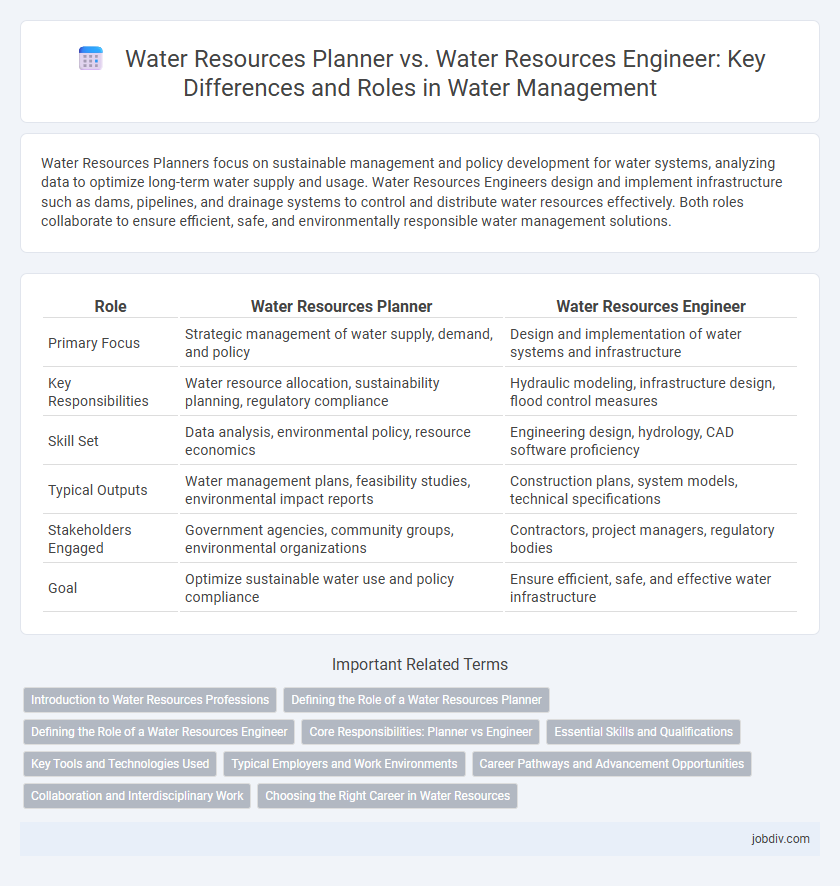Water Resources Planners focus on sustainable management and policy development for water systems, analyzing data to optimize long-term water supply and usage. Water Resources Engineers design and implement infrastructure such as dams, pipelines, and drainage systems to control and distribute water resources effectively. Both roles collaborate to ensure efficient, safe, and environmentally responsible water management solutions.
Table of Comparison
| Role | Water Resources Planner | Water Resources Engineer |
|---|---|---|
| Primary Focus | Strategic management of water supply, demand, and policy | Design and implementation of water systems and infrastructure |
| Key Responsibilities | Water resource allocation, sustainability planning, regulatory compliance | Hydraulic modeling, infrastructure design, flood control measures |
| Skill Set | Data analysis, environmental policy, resource economics | Engineering design, hydrology, CAD software proficiency |
| Typical Outputs | Water management plans, feasibility studies, environmental impact reports | Construction plans, system models, technical specifications |
| Stakeholders Engaged | Government agencies, community groups, environmental organizations | Contractors, project managers, regulatory bodies |
| Goal | Optimize sustainable water use and policy compliance | Ensure efficient, safe, and effective water infrastructure |
Introduction to Water Resources Professions
Water resources planners develop strategic frameworks for sustainable water management, focusing on policy development, resource allocation, and long-term planning to address water scarcity and environmental impacts. Water resources engineers apply engineering principles to design, construct, and maintain infrastructure such as dams, irrigation systems, and wastewater treatment plants, ensuring effective water distribution and quality control. Both professions play critical roles in managing the world's water supply, combining expertise in hydrology, environmental science, and resource management to support resilient water systems.
Defining the Role of a Water Resources Planner
A Water Resources Planner specializes in developing sustainable strategies for managing water supply, allocation, and conservation to meet community and environmental needs. They analyze data on water availability, demand, and infrastructure to create long-term plans that support urban development and agricultural growth. Their role involves collaboration with policymakers and stakeholders to ensure resilient water resource management.
Defining the Role of a Water Resources Engineer
A Water Resources Engineer focuses on designing, developing, and managing infrastructure projects related to water supply, flood control, and wastewater treatment, applying engineering principles to solve complex hydrological challenges. Their role involves analyzing data, creating models, and implementing systems that optimize water distribution and quality while ensuring environmental sustainability. Unlike Water Resources Planners, who emphasize policy and resource management strategies, engineers concentrate on the technical and structural aspects of water resource systems.
Core Responsibilities: Planner vs Engineer
Water Resources Planners focus on developing strategic frameworks for sustainable water management, integrating environmental, economic, and social factors to ensure long-term resource availability. Water Resources Engineers design, analyze, and implement infrastructure such as dams, canals, and treatment facilities to optimize water distribution and quality. Planners emphasize policy development and stakeholder coordination, while engineers concentrate on technical solutions and system performance.
Essential Skills and Qualifications
Water Resources Planners require strong analytical skills, proficiency in geographic information systems (GIS), and knowledge of environmental regulations to develop sustainable water management strategies. Water Resources Engineers must possess advanced engineering expertise, including hydrology, hydraulics, and civil design, coupled with the ability to apply mathematical models for water system infrastructure. Both roles benefit from project management experience, understanding of water laws, and effective communication skills for interdisciplinary collaboration.
Key Tools and Technologies Used
Water Resources Planners primarily utilize geographic information systems (GIS), hydrological modeling software like HEC-HMS, and data analysis tools to forecast water availability and manage sustainable resource allocation. Water Resources Engineers focus on engineering design software such as AutoCAD Civil 3D, hydraulic modeling tools like HEC-RAS, and construction management technologies to develop infrastructure for water distribution and flood control. Both roles integrate advanced remote sensing and real-time monitoring systems to optimize water resource management and ensure environmental compliance.
Typical Employers and Work Environments
Water Resources Planners typically find employment with government agencies, environmental consulting firms, and regional planning commissions, operating in office settings and field sites for data collection. Water Resources Engineers often work for engineering consulting companies, public utilities, and construction firms, engaging in both office design work and on-site project management. Both roles require collaboration with regulatory bodies and stakeholders to develop sustainable water management solutions.
Career Pathways and Advancement Opportunities
Water Resources Planners specialize in strategic management and policy development for sustainable water usage, often collaborating with government agencies to design effective water supply systems and conservation programs. Water Resources Engineers focus on the technical design, construction, and maintenance of infrastructure such as dams, levees, and treatment plants, utilizing hydrological data and engineering principles. Career advancement for Planners typically involves roles in policy advising and environmental consultancy, while Engineers progress through technical leadership and project management positions in engineering firms or public works departments.
Collaboration and Interdisciplinary Work
Water Resources Planners and Water Resources Engineers collaborate to develop sustainable water management strategies by integrating hydrological data, environmental science, and infrastructure design. Their interdisciplinary work combines policy analysis, ecological assessments, and engineering solutions to address water scarcity, flood control, and resource allocation effectively. This collaboration enhances project outcomes by merging technical expertise with regulatory compliance and community needs.
Choosing the Right Career in Water Resources
Water Resources Planners focus on developing sustainable management strategies by analyzing water availability, demand, and policy impacts, while Water Resources Engineers design infrastructure such as dams, canals, and treatment systems to control water flow and ensure supply. Both careers require expertise in hydrology and environmental science, but planners emphasize policy, economics, and resource optimization, whereas engineers prioritize technical design and implementation. Choosing the right career depends on whether you prefer strategic planning and policy development or hands-on engineering and infrastructure projects in water resource management.
Water Resources Planner vs Water Resources Engineer Infographic

 jobdiv.com
jobdiv.com